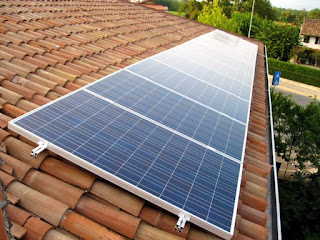The role of photovoltaic modules is to convert the incident solar energy into electricity. When they receive a certain amount of light, the photovoltaic surfaces (cells or thin films) integrated into a module (also called panel) begin to produce electricity in the form of direct current. To achieve this, the technologies used are diverse and rapidly evolving. In recent years, the breakthrough of building integration applications has also assumed photovoltaic modules as architectural functions such as roofing, solar shading, lightening, cladding or glass roofing.
Very fragile in the raw state, photovoltaic materials must be protected from the weather, which is generally achieved by a transparent and solid glass which constitutes the upper part of a sandwich studied to withstand the aggressions of the environment for several decades.
The rear face of the sandwich may be constituted by a specially designed cured polymer or by a second layer of glass, thus allowing a semi-transparency of the assembly.
The most common modules today are rigid rectangular panels with a surface area between 0.5 and 3 m 2 , a few centimeters thick and weighing a few tens of kilograms.
Subject to the Sun's radiation (ultra-violet, infrared ...) and to the weather, the materials of the photovoltaic solar panels gradually degrade.
The modules of the first photovoltaic installation in France connected to the state grid, commissioned by the HESPUL association in 1992, were tested in 2012. This study, carried out by the CEA laboratories of the National Institute of Solar Energy ) and the certification body CERTISOLIS, concludes that the modules lost only 8.3% of their initial power after 20 years of use.
Currently, the main manufacturers such as Greco Solar guarantee a maximum power reduction of about 20% over 20 or 25 years. The result of this study shows that the performance of these modules is far superior to the guaranteed values.
 |
| photovoltaic solar panels |
The rear face of the sandwich may be constituted by a specially designed cured polymer or by a second layer of glass, thus allowing a semi-transparency of the assembly.
The most common modules today are rigid rectangular panels with a surface area between 0.5 and 3 m 2 , a few centimeters thick and weighing a few tens of kilograms.
Subject to the Sun's radiation (ultra-violet, infrared ...) and to the weather, the materials of the photovoltaic solar panels gradually degrade.
The modules of the first photovoltaic installation in France connected to the state grid, commissioned by the HESPUL association in 1992, were tested in 2012. This study, carried out by the CEA laboratories of the National Institute of Solar Energy ) and the certification body CERTISOLIS, concludes that the modules lost only 8.3% of their initial power after 20 years of use.
Currently, the main manufacturers such as Greco Solar guarantee a maximum power reduction of about 20% over 20 or 25 years. The result of this study shows that the performance of these modules is far superior to the guaranteed values.
No comments:
Post a Comment